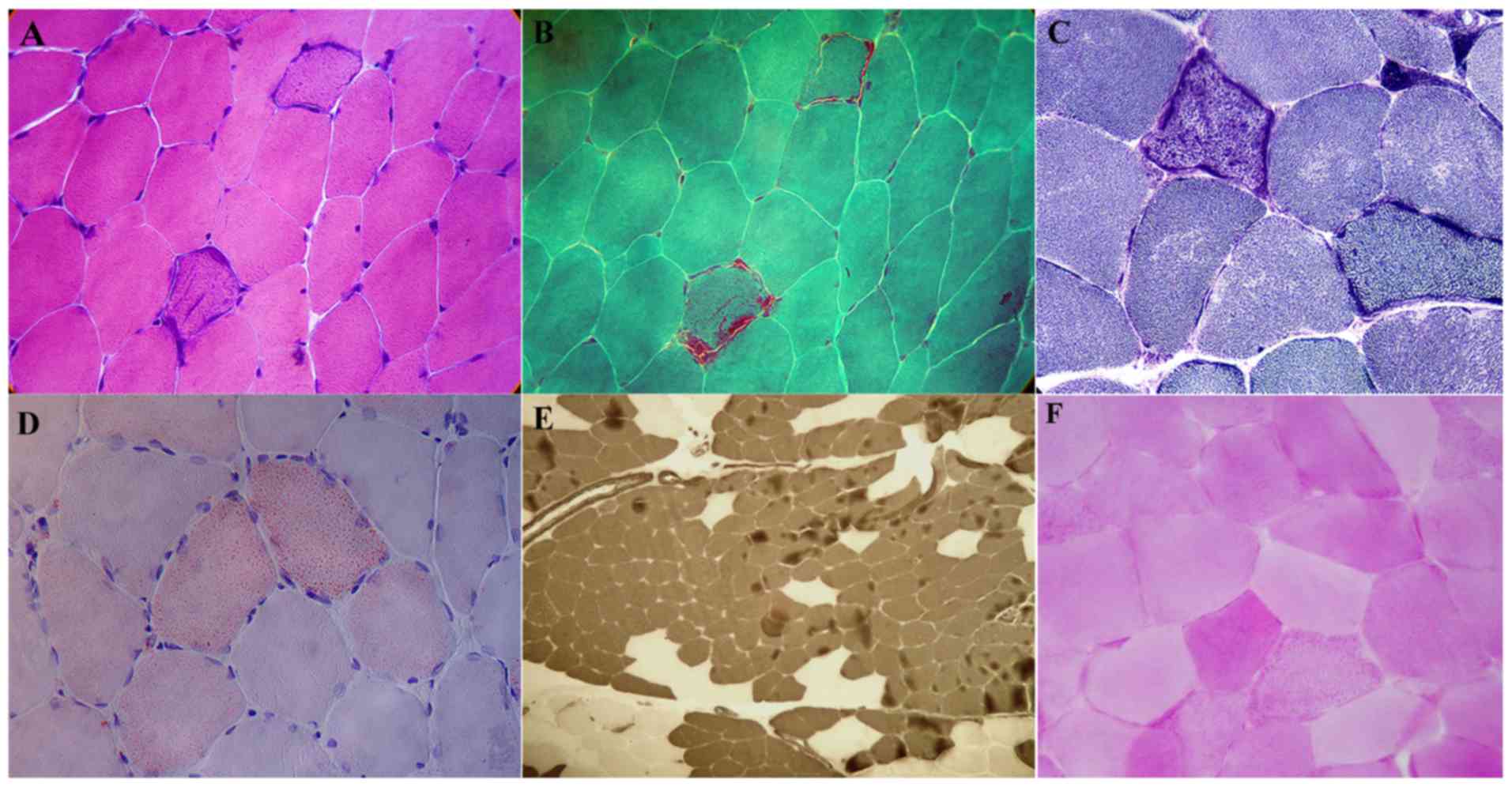|
1
|
López-Gallardo E, López-Pérez MJ, Montoya
J and Ruiz-Pesini E: CPEO and KSS differ in the percentage and
location of the mtDNA deletion. Mitochondrion. 9:314–317.
2009.PubMed/NCBI View Article : Google Scholar
|
|
2
|
Negro R, Zoccolella S, Dell’aglio R, Amati
A, Artuso L, Bisceglia L, Lavolpe V, Papa S, Serlenga L and
Petruzzella V: Molecular analysis in a family presenting with a
mild form of late-onset autosomal dominant chronic progressive
external ophthalmoplegia. Neuromuscul Disord. 19:423–426.
2009.PubMed/NCBI View Article : Google Scholar
|
|
3
|
Murdock J, Thyparampil PJ and Yen MT:
Late-onset development of eyelid ptosis in chronic progressive
external ophthalmoplegia: A 30-year follow-up. Neuroophthalmology.
40:44–46. 2016.PubMed/NCBI View Article : Google Scholar
|
|
4
|
Filosto M, Mancuso M, Nishigaki Y,
Pancrudo J, Harati Y, Gooch C, Mankodi A, Bayne L, Bonilla E,
Shanske S, et al: Clinical and genetic heterogeneity in progressive
external ophthalmoplegia due to mutations in polymerase γ. Arch
Neurol. 60:1279–1284. 2003.PubMed/NCBI View Article : Google Scholar
|
|
5
|
Brandon BR, Diederich NJ, Soni M, Witte K,
Weinhold M, Krause M and Jackson S: Autosomal dominant mutations in
POLG and C10orf2: Association with late onset chronic progressive
external ophthalmoplegia and Parkinsonism in two patients. J
Neurol. 260:1931–1933. 2013.PubMed/NCBI View Article : Google Scholar
|
|
6
|
Walker UA, Collins S and Byrne E:
Respiratory chain encephalomyopathies: A diagnostic classification.
Eur Neurol. 36:260–267. 1996.PubMed/NCBI View Article : Google Scholar
|
|
7
|
Chaturvedi S, Bala K, Thakur R and Suri V:
Mitochondrial encephalomyopathies: Advances in understanding. Med
Sci Monit. 11:RA238–RA246. 2005.PubMed/NCBI
|
|
8
|
Biousse V and Newman NJ:
Neuro-ophthalmology of mitochondrial diseases. Curr Opin Neurol.
16:35–43. 2003.PubMed/NCBI View Article : Google Scholar
|
|
9
|
Bing Q, Hu J, Li N, Zhao Z, Shen HR and
Yuan HH: Clinical and pathological features of chronic progressive
external ophthalmoplegia. Linchuang Shenjingbingxue Zazhi.
22:175–177. 2009.(In Chinese).
|
|
10
|
Sun L, Lu JH and Lu ZZ: Clinical
manifestations, pathological changes and diagnosis of chronic
progressive external ophthalmoplegia (twelve cases attached). Fudan
Daxue Yixueban. 36:212–215. 2009.(In Chinese).
|
|
11
|
Wallace DK, Sprunger DT, Helveston EM and
Ellis FD: Surgical management of strabismus associated with chronic
progressive external ophthalmoplegia. Ophthalmology. 104:695–700.
1997.PubMed/NCBI View Article : Google Scholar
|
|
12
|
Wu JL, Yan CZ, Wang QZ, Liu SP, Gao SQ,
Zhang YQ and Li DN: Chronic progressive external ophthalmophegia:
Clinical and pathological analysis of 22 cases. Zhonghua Shenjinke
Zazhi. 38:737–740. 2005.(In Chinese).
|
|
13
|
Fournier E and Tabti N: Clinical
electrophysiology of muscle diseases and episodic muscle disorders.
Handb Clin Neurol. 161:269–280. 2019.PubMed/NCBI View Article : Google Scholar
|
|
14
|
Engel WK and Cunningham GG: Rapid
examination of muscle tissue. An improved trichrome method for
fresh-frozen biopsy sections. Neurology. 13:919–923.
1963.PubMed/NCBI View Article : Google Scholar
|
|
15
|
Shapira Y, Harel S and Russell A:
Mitochondrial encephalomyopathies: A group of neuromuscular
disorders with defects in oxidative metabolism. Isr J Med Sci.
13:161–164. 1977.PubMed/NCBI
|
|
16
|
Yamamoto M and Nonaka I: Skeletal muscle
pathology in chronic progressive external ophthalmoplegia with
ragged-red fibers. Acta Neuropathol. 76:558–563. 1988.PubMed/NCBI View Article : Google Scholar
|
|
17
|
Lee SJ, Na JH, Han J and Lee YM:
Ophthalmoplegia in mitochondrial disease. Yonsei Med J.
59:1190–1196. 2018.PubMed/NCBI View Article : Google Scholar
|
|
18
|
Sachdev A, Fratter C and McMullan TF:
Novel mutation in the RNASEH1 gene in a chronic progressive
external ophthalmoplegia patient. Can J Ophthalmol. 53:e203–e205.
2018.PubMed/NCBI View Article : Google Scholar
|
|
19
|
Viscomi C and Zeviani M: MtDNA-maintenance
defects: Syndromes and genes. J Inherit Metab Dis. 40:587–599.
2017.PubMed/NCBI View Article : Google Scholar
|
|
20
|
Sundaram C, Meena AK, Uppin MS, Govindaraj
P, Vanniarajan A, Thangaraj K, Kaul S, Kekunnaya R and Murthy JM:
Contribution of muscle biopsy and genetics to the diagnosis of
chronic progressive external opthalmoplegia of mitochondrial
origin. J Clin Neurosci. 18:535–538. 2011.PubMed/NCBI View Article : Google Scholar
|
|
21
|
Lehmann D, Kornhuber ME, Clajus C, Alston
CL, Wienke A, Deschauer M, Taylor RW and Zierz S: Peripheral
neuropathy in patients with CPEO associated with single and
multiple mtDNA deletions. Neurol Genet. 2(e113)2016.PubMed/NCBI View Article : Google Scholar
|












